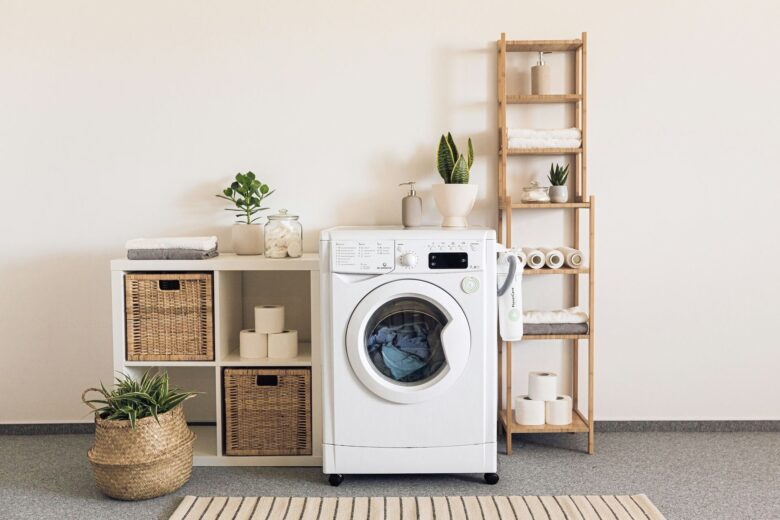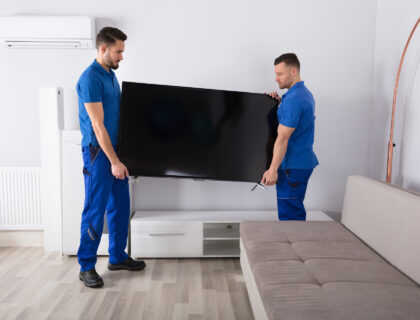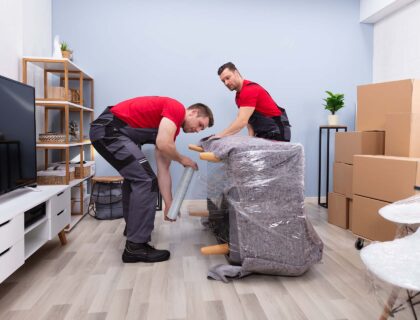

Relocating heavy and bulky appliances safely and efficiently requires careful planning, the right tools, and a bit of know-how. From refrigerators and washing machines to ovens and dishwashers, each appliance presents its own set of challenges during a relocation. This guide on how to move appliances easily aims to equip you with the necessary strategies and appliance moving tips.
How to Move Appliances to a New Home
Moving heavy appliances efficiently involves careful planning and execution. Start by cleaning and preparing the appliances, securing loose parts, and disconnecting utilities. Utilize proper lifting techniques and equipment like dollies and lifting straps for safe transport. Upon arrival, reinstall and reconnect appliances, ensuring they’re properly positioned and functional in the new space.
Pre-Move Preparation – Getting the Appliances Ready
The first step on the how to move heavy appliances to-do list is preparing them for the long journey of moving abroad. Preparing them for relocating is a crucial step that not only ensures their safety during transport but also simplifies their installation and use in a new home. This preparation involves thorough cleaning and maintenance, along with securing any loose parts and detachable components.
Start With Cleaning and Maintenance
Different types of appliances need different approaches when it comes to preparing for the move. For refrigerators and freezers – begin by defrosting the freezer at least 48 hours before the relocation, ensuring all water is drained and wiped away.
Remove all shelves, bins, and other detachable parts, wash them with warm soapy water, and let them dry completely. Then, clean it with a baking soda solution (one tablespoon of baking soda per a bit of water) to eliminate odors and wipe the exterior with a gentle cleaner. Check the manufacturer’s guide for any specific maintenance steps, such as securing the compressor or connecting rods.
When it comes to stoves and ovens – ensure that the appliance is completely cool before you start. For gas stoves, disconnect the gas supply carefully, preferably by a professional. Clean the stovetop with a suitable cleaner and remove any detachable parts, such as burners, knobs, and racks, cleaning them separately. Use a degreaser if necessary, especially in ovens, to remove any buildup.
For those relocating washing machines and dryers – clean the interior drum of the washing machine with a mild detergent and run a cycle with just water to rinse it out. Disconnect and drain all hoses, letting them dry to prevent mold. Dryers should be cleaned of lint, not just from the lint trap but also from the vent and back of the machine.
Securing Loose Parts and Detachable Components
Once cleaning is completed, securing loose parts and detachable components is the next critical step. For refrigerators, secure or remove shelves and drawers. If removed, pack these separately with appropriate cushioning material. Use strong tape to secure the doors during the relocation, but remember to prop them open once in place to prevent mold growth until installation.
For stoves, secure or remove knobs and burner covers. If the stove has a removable glass top or doors, remove and pack them separately. Secure any moveable parts or wires and tape the door shut. In washing machines and dryers, aside from securing the drum if applicable, also look for any removable trays or dispensers. Tape the power cord and any hoses to the side of the appliance to prevent tripping or damage.

Essential Supplies and Tools for Moving Appliances
Relocating heavy appliances requires not just muscle power but also the right equipment and packing materials to ensure the relocation is safe and damage-free. Here’s a breakdown of the essential items you’ll need to gather before the big moving day.
Gathering the Right Materials Is Crucial
Having proper, high-quality supplies will ensure your items arrive at the new home without a scratch. The essential packing supplies and equipment include:
- Appliance dolly – An indispensable tool for relocating heavy items. It should have straps and rubber or soft wheels to protect floors.
- Furniture straps – While usually used to relocate furniture, these straps help secure the appliance to the dolly, ensuring it doesn’t slip off while being moved.
- Relocation blankets – Thick, padded blankets protect from scratches, dents, and other damage during the relocation.
- Bubble wrap – It offers additional protection for sensitive parts or glass components of appliances.
- Stretch wrap – It’s useful for keeping doors and cords secured against the appliance body during the relocation.
- Packing tape – Strong tape is needed to secure the wrap and blankets in place.
- Plywood sheets – They can be used to create a smooth surface over stairs or uneven terrain and help protect floors against scratches.
- Gloves – A pair of sturdy gloves can provide a better grip and protect your hands during the relocation.
- Measuring tape – Essential for measuring doorways and appliances to ensure they will fit through transitions.
Preparing Appliances for Packing
When preparing appliances for packing, it’s essential to prioritize their protection to ensure they arrive at their destination unscathed. Begin by wrapping them in relocation blankets, ensuring that every surface is covered to prevent scratches or dents during transit. For extra fragile items or parts, such as glass shelves or control panels, add an additional layer of protection with bubble wrap.
Secure the blankets and bubble wrap in place using packing tape, ensuring they remain firmly attached throughout the process of moving internationally. These measures provide a reliable shield against damage and help maintain the appliances’ integrity during transportation.

Step-by-Step Guide to Moving Specific Appliances
Moving large appliances from one home to another involves a series of careful preparations and handling to ensure their safety and functionality upon arrival. So, here’s a detailed guide on how to manage the relocation of refrigerators, stoves, ovens, and washing machines.
Safely Transporting a Refrigerator
When it comes to relocating a refrigerator, the process starts with emptying and defrosting it, which should begin at least 24-48 hours prior to the relocation. This involves unplugging the unit and leaving doors open to allow ice to melt, with towels placed around to catch any water. After defrosting, a thorough cleaning of the interior and removal of all shelves and bins should follow, with these items being packed separately.
Relocating the refrigerator requires securing its doors and power cord with stretch wrap or straps. For models with an ice maker or water dispenser, the water line needs to be disconnected and drained. Transporting the refrigerator upright on an appliance dolly is crucial to avoid coolant leaks, though slight tilting is permissible when absolutely necessary.
Upon arrival at the new location, let the refrigerator stand upright for at least 24 hours before reconnecting to allow the compressor oil to settle, then reconnect the water line, reinstall the shelves and bins, and turn it on.
Relocating Stoves and Ovens with Care
Preparing a stove or oven for moving overseas starts with ensuring the appliance is cool. For gas models, this means shutting off and disconnecting the gas supply carefully, while electric models can be unplugged directly. Securing loose parts like knobs, grates, or burners is next, with relocation blankets used to wrap the appliance and protect it from damage.
Using lifting straps or a dolly helps in transporting the stove or oven, which should be secured with straps for stability. Once at the new home, reconnecting the appliance, especially for gas models, should be done with care to prevent leaks.
Handling Washing Machines and Dryers
To relocate a washing machine, first disconnect it from the power and water supply, draining all hoses and the machine itself to avoid water spillage. Reinstalling transit bolts can help secure the drum during transport. For dryers, the lint trap should be cleaned and the appliance unplugged – if it’s a gas dryer, disconnect the gas line and cap it securely.
Wrapping both appliances in relocation blankets and using a dolly for transportation ensures their safety. Upon arrival, washing machines should be reconnected to the water supply after removing any transit bolts, while dryers need to be plugged in and, for gas models, connected to the gas supply with a careful check for leaks.
Loading and Unloading Appliances – Best Practices
Loading and unloading appliances requires careful attention to ensure their safety and protection during transportation.
Proper techniques and equipment can help prevent damage and streamline the process.
From securing appliances onto the truck to setting them up in a new home, following best practices is essential for a successful and efficient move.
Techniques for Safe Loading
Safely loading appliances onto a relocation truck is essential to prevent damage and ensure a smooth transition. Utilizing dollies, lifting straps, and teamwork is crucial for this task. Begin by assessing the weight and dimensions of each appliance to determine the best approach.
Use appliance dollies with straps to securely transport heavier items like refrigerators and washing machines. When lifting, always bend the knees and lift with the legs to avoid strain. Enlist the help of others to assist with maneuvering and navigating tight spaces. Communication is key to coordinating movements and ensuring everyone’s safety during the loading process.
Unloading and Installing Appliances in the New Home
Once the moving truck arrives at the new home, unloading appliances safely is the next priority. Begin by carefully removing each appliance from the truck using dollies or lifting straps as needed. Take care to avoid sudden movements or drops that could cause damage. Once inside, carefully position each appliance in its designated space, ensuring adequate clearance for ventilation and access to utility connections.
Use a level to ensure that appliances like refrigerators and washing machines are properly aligned and stable. Finally, reconnect power and water supplies, ensuring all connections are secure and leak-free.

The Role of Professional Movers in Appliance Relocation
Professional appliance movers are essential for efficiently relocating appliances, offering expertise and convenience throughout the process. Their specialized skills and equipment ensure the safe transportation of bulky items like refrigerators and washing machines.
With adept maneuvering techniques, a reliable company such as Schmidt International Relocations can minimize the risk of damage or relocation mistakes to both the appliances and surrounding property, making the move easier and less stressful. Additionally, professional movers often handle tasks such as disassembly, packing appliances for moving, and installation, providing comprehensive moving and packing services that save time and ensure peace of mind.
When to Hire an International Moving Company
Hiring professional movers is particularly beneficial for appliance relocation in various scenarios. If you’re dealing with large, heavy, or complex appliances such as refrigerators, washing machines, or ovens, their expertise becomes invaluable.
Additionally, if you’re moving to a location with multiple stories or tight spaces, professional assistance can streamline the process and minimize the risk of damage. Ultimately, factors like the size, weight, and complexity of the appliances, coupled with your own capabilities and circumstances, can help determine whether professional movers are necessary.
Benefits of Professional Appliance Relocation Services
Professional movers offer a range of advantages for appliance relocation. Their expertise in handling heavy items ensures safe transportation, minimizing the risk of damage to both the appliances and your property. Moreover, they come equipped with the right tools and equipment, such as appliance dollies and straps, which enable efficient and secure transportation.
Another significant benefit is their insurance coverage for damages, providing peace of mind knowing that the appliances are protected in case of accidents. Overall, the convenience, expertise, and assurance provided by professional moving services by sea or by air freight make them an invaluable resource for appliance relocation.

Appliance Relocation – Safeguarding the Move With Care and Precision
Moving appliances across the world requires attention to detail, proper preparation, and sometimes the assistance of professional movers. By following the outlined steps, individuals can navigate the relocation process with greater ease and minimize the risk of damage to their valuable appliances.
However, hiring a moving company to take care of all the heavy lifting ensures a stress-free and smooth relocation, so contact us at Schmidt International Relocations and ensure a safe move of all your belongings.
Frequently Asked Questions
How Do I Relocate a Refrigerator Without Damaging It?
To relocate a refrigerator without causing damage, start by defrosting it and cleaning the interior thoroughly. Secure the doors with tape or straps and use a dolly for transport. Alternatively, you can always hire professional movers who have experience in handling heavy appliances safely.
Can I Move a Washing Machine by Myself?
Moving a washing machine alone is possible with proper preparation. Start by disconnecting the water and power supply, draining any remaining water, and securing the drum. Use lifting straps or a dolly for transport, ensuring to lift with the legs and not the back to avoid injury.
What Should I Do With My Appliances Before Moving Day?
Before moving day, it’s essential to prepare appliances properly. Clean and dry them thoroughly, disconnect utilities, and secure any loose parts. Additionally, you can wrap them in protective materials like relocation blankets or bubble wrap to prevent things from breaking during transit.
How Can Professional Movers Help With Appliance Relocation?
Professional movers can assist with appliance relocation in various ways. They have the expertise to handle heavy items safely, the right equipment like dollies and lifting straps, and insurance coverage for damages.
What Are the Risks of Moving Appliances Without Professional Help?
Moving appliances without professional help poses several risks. Improper lifting techniques can lead to injury, while mishandling may cause damage to the appliances or property.












